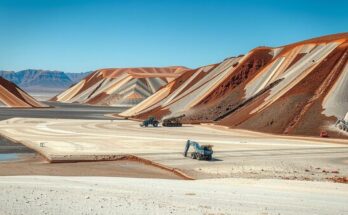The Government of Liberia has requested ArcelorMittal Liberia to allow Ivanhoe Atlantic to conduct an Environmental and Social Impact Assessment along the Yekepa-Buchanan railway, marking a key step in implementing a multiuser rail policy intended to open rail access for multiple companies, enhance economic benefits, and ensure regulatory compliance.
The Government of Liberia has initiated a significant move towards executing its multiuser rail policy by formally requesting ArcelorMittal Liberia (AML) to grant Ivanhoe Atlantic access for an Environmental and Social Impact Assessment (ESIA) along the Yekepa-Buchanan railway. This decision, communicated through letters from the Ministry of Mines and Energy and the Ministry of Transport, indicates a commitment to enhancing the nation’s rail infrastructure by allowing multiple users, thereby fostering economic benefits and compliance with regulations.
The letters, addressed to AML CEO Michiel van der Merwe, specifically instruct the company to facilitate the ESIA for Ivanhoe Atlantic, scheduled for March 17-21, 2025. The Ministry of Mines and Energy references Section 1 of the 2005 Mineral Development Agreement (MDA), asserting that as a licensed entity, Ivanhoe Atlantic must conduct the ESIA as a necessary step for its impending mining and transportation operations within Liberia.
The Ministry of Transport supports this viewpoint by highlighting that the Environmental Protection Agency (EPA) has deemed the ESIA essential for Ivanhoe Atlantic’s activities. The directive reassured AML that the assessment would not disturb its ongoing operations and appointed Mr. Daniel Kpehe Bolay, Assistant Director of Rail at the Ministry of Transport, to oversee the process, ensuring effective coordination.
Historically, the Yekepa-Buchanan railway, measuring 360 kilometers and vital for iron ore exports, has been exclusively managed by AML, as stipulated in the MDA. However, with the adoption of Executive Order 136, the government is instituting a multiuser rail policy that would allow multiple companies to access the railway, thus enhancing revenue generation significantly.
The current directive marks a transition from theoretical discussions to practical enactment of policies. Allowing Ivanhoe Atlantic access for an ESIA signals Liberia’s preparation for a diversified railway user landscape, particularly significant as the company anticipates evacuating 30 million tonnes of iron ore annually once operations commence.
An Environmental and Social Impact Assessment (ESIA) is an essential prerequisite for large-scale industrial projects, assessing potential environmental, social, and economic impacts while identifying and mitigating risks. In mining and rail transport contexts, the ESIA will analyze several factors:
1. Community Impact: Includes considerations on displacement, job creation, and daily life effects due to mining and transport.
2. Environmental Risks: Focus on issues such as deforestation, pollution, and biodiversity concerns along the railway corridor.
3. Safety of Rail Infrastructure: Examination of the railway’s capacity for increased traffic and necessary upgrades.
For communities adjacent to the Yekepa-Buchanan railway, this ESIA represents a preliminary step towards expanded economic activity. Unlike AML’s operations, which have faced criticism for limited community benefits, a multiuser rail system could facilitate job creation, infrastructure enhancements, and social development initiatives.
AML now faces the challenge of compliance with the government’s directive. Historically, AML had resisted any attempts to diversify rail usage, citing exclusive control granted by its MDA. However, it must recognize that under the current agreement, blocking an environmental study is not permissible. Since the ESIA is a regulatory obligation rather than a commercial negotiation, AML has little legal basis to refuse access.
Despite recent legal objections from AML regarding the multiuser rail initiative, including threats of international arbitration, Liberia’s position is supported by a 2022 legal opinion stating the government’s sovereign rights to manage and expand rail access. By moving forward with the ESIA, the government is unambiguously signaling its resolve to implement national infrastructure policies without AML’s endorsement.
This progress is particularly timely as Liberia seeks to attract international investors and mining entities eager to exploit the country’s iron ore resources. The lack of rail access has previously discouraged investments due to AML’s monopoly. The advancement of Ivanhoe Atlantic’s ESIA may inspire confidence among potential investors that Liberia is serious about dismantling this monopoly and promoting open infrastructure, potentially accelerating funding for additional rail-linked ventures.
Consequently, AML must decide whether to comply with the government’s request and facilitate the ESIA, demonstrating cooperation with the multiuser rail framework, or to resist, which could heighten tensions with the government. Given the involvement of oversight personnel from the Ministry of Transport, AML may find it challenging to block the process without facing further governmental scrutiny.
Simultaneously, Ivanhoe Atlantic is poised to initiate Feasibility and Engineering Studies for the Liberty Corridor, a separate rail project aimed at diminishing reliance on a singular rail line. If AML continues opposing the multiuser model, it risks losing significance in Liberia’s long-term infrastructure plan as other firms engage with the railway system.
In conclusion, Liberia’s advancement toward an ESIA for Ivanhoe Atlantic, despite AML’s longstanding control, marks a crucial milestone in the nation’s economic transformation. The government’s directive signifies a robust commitment to enforcing a multiuser policy and ensuring that national infrastructure is beneficial to a diverse range of stakeholders, rather than favoring a single corporation. The forthcoming actions of AML will be closely monitored, but it is evident that Liberia’s multiuser rail system is progressing from concept to reality, signifying substantial development toward a competitive and open business environment for investors.
The Government of Liberia’s directive for ArcelorMittal Liberia to allow Ivanhoe Atlantic access for an Environmental and Social Impact Assessment symbolizes a critical advancement in the nation’s economic landscape. This action not only empowers multiple stakeholders to utilize the railway but also reflects Liberia’s commitment to fostering an open and competitive business environment. With significant implications for local communities and potential investors, the multiuser rail policy is transitioning from theory to execution, highlighting the government’s resolve to implement significant infrastructure reforms.
Original Source: www.liberianobserver.com




